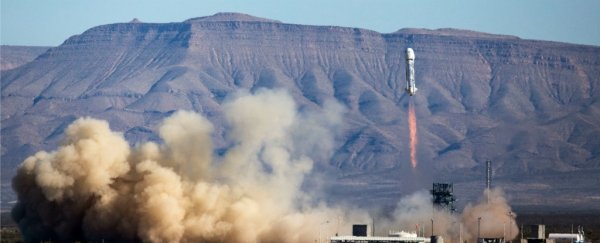This Friday, for the first time ever, Blue Origin – the private spaceflight company that intends to one day send tourists to orbit – will live stream one of its New Shepard test launches.
While an exact time hasn't been announced – updates will likely come from company's website – reports indicate that the launch will end in an intentional crash landing to test how well the craft performs in the event of a disaster.
"We're planning to demonstrate the redundancies built into the capsule on this re-flight of the vehicle by intentionally failing one drogue and one main parachute during descent," Blue Origin CEO, Jeff Bezos, said in a newsletter. "This should occur around 7.5 minutes into the flight, at an altitude of 24,000 feet [7,315 metres]."
 Blue Origin
Blue Origin
This will mark the fourth time that Blue Origin has test launched their New Shepard rocket and capsule.
All previous tests have been successful, yet kept under wraps until they were complete. No one's sure why Blue Origin has been so secretive about their launches, but many believe the live stream is an effort by the company to be more transparent, especially if they intend to send wealthy tourists to space.
So what should we expect to see? Well, if this goes anything like the three previous tests, the New Shepard rocket and capsule will launch from a site in West Texas. After lift-off, the rocket will take the capsule up into the sky where it will break off and begin its descent back to Earth.
Meanwhile, the crew capsule will continue rising to a height of 60 miles (96.5 kilometres) above Earth, which – when the spacecraft is ready for actual passengers – will provide up to six people a breathtaking view of our planet.
Four weightless minutes later, the capsule starts to fall back to the ground. Around this time, the New Shepard rocket will be touching down on a landing pad at a remarkably slow speed of around 4.2 miles per hour (6.7 kilometres per hour), providing a soft enough landing that it can be reused in the future.
The capsule will then land somewhere near the launch site after floating down with a parachute. When all is said and done, the capsule and the rocket will get taken away, refurbished, and used again.
 Blue Origin
Blue Origin
For this flight, though, the team intends to crash the capsule to basically see how well it will hold up, should something befall the parachute. This is the first time Blue Origin will do this, which makes it all the more exciting.
"The crew capsule is equipped with a two-stage crushable structure that absorbs landing loads, along with seats that use a passive energy-absorbing mechanism to reduce peak loads to the occupant," Bezos wrote in the newsletter.
"As an added measure of redundancy, the crew capsule is equipped with a 'retro rocket' propulsive system that activates just a few feet above the ground to lower the velocity to approximately 3 feet per second [0.9 metres per second] at touchdown. This final manoeuvre causes the dust cloud you can see when the crew capsule lands," he continued.
Going forward, Blue Origin plans to carry out more of these test launches throughout the remainder of 2016. Next year, test pilots are rumoured to start flying in the New Shepard capsule to make way for tourists in 2018.
Having said that, it should be made clear that 2018 is a very speculative date that depends on the success of the upcoming tests. But that's kind of perfect, because it gives us time to save up for our trips to space…
Check out out the video below to see footage of the last test launch, which sent New Shepard 64 miles (103 kilometres) up into the sky!
